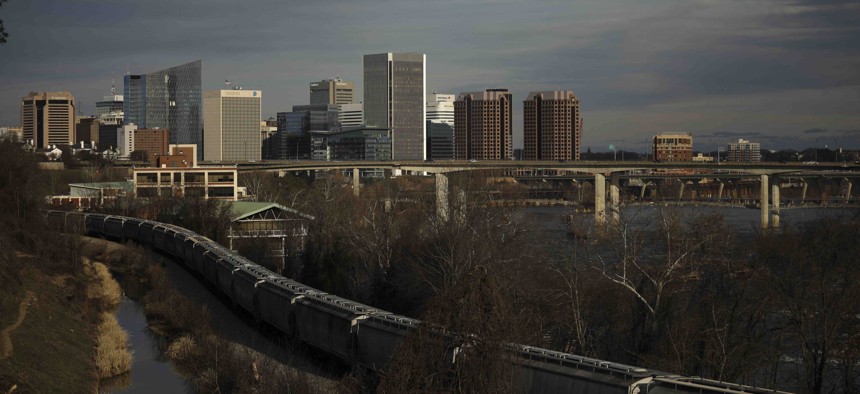A Looming Threat for City Budgets

The downtown Richmond skyline stands in the late afternoon, February 8, 2019 in Richmond, Virginia. Drew Angerer / Getty Images Staff
The rise of remote work could permanently reduce the number of people coming into cities, eroding taxes and fees on everything from coffee sales to parking.
As remote work becomes less of a temporary fix and more of a permanent fixture in the American workplace, city governments accustomed to steady streams of commuters could face a sizable hit to their budgets, an advocacy group warned Tuesday.
“Many cities rely on those who work there—but do not live there—for revenue. Commuter-driven revenue could come from the sales tax on a morning coffee, a tax on wages earned in the city, or parking fees,” wrote Jeff Chapman, the director of state fiscal health for The Pew Charitable Trusts.
“Fewer commuters—or workers who commute less often—could translate into a shrinking local revenue base and contribute to long-term fiscal challenges for local governments,” he wrote.
But the size of that impact will depend greatly both on the number of commuters who go in and out of the city every day, and the types of jobs that are prevalent there, Chapman explained. After all, some jobs are more easily done remotely than others. White-collar jobs in finance, professional services and management are more easily done from afar than jobs in the service and hospitality industries.
Highly skilled tech workers, for example, are leaving offices in droves to work remotely, a talent recruiter recently told The New York Times. Candidates used to be most concerned about salary but now it's remote flexibility, she said.
A number of large companies including Facebook, Twitter and outdoor retailer REI have said they will let more employees work remotely after the pandemic is over.
Remote Work Impacts
Pew examined the ways that those two factors could potentially impact 10 cities of varying sizes.
Richmond, the Virginia capital city, had 77% of its workers commute into the city in 2019, the highest among the places Pew examined. New York City, on the other hand, only had 28% of its workers come from other jurisdictions, the lowest among the cities Pew looked at, although much of that is because so many New Yorkers go from one borough to another to work.
San Francisco, meanwhile, had the highest share of workers in industries where remote working was common, with 29%. On the other end of the spectrum, Carson City, Nevada’s capital, had only 7% of its workers in the finance, professional services or management sectors.
Another factor that could determine how vulnerable cities are to permanent changes in working arrangements are the local tax structures, the Pew report noted.
“Cities that rely more heavily on property taxes—which may be less affected by changes in commuting patterns and do not collect income or sales tax, for example—could be more resilient to long-term shifts to remote work,” Chapman wrote.
Besides Carson City, New York, Richmond and San Francisco, Pew analyzed the share of commuters in: Baltimore; Washington, D.C.; Denver; New Orleans; Philadelphia; and St. Louis. For more information from the review click here.
Daniel C. Vock is a senior reporter at Route Fifty and is based in Washington, D.C.
NEXT STORY: States With the Highest and Lowest Gasoline Prices






